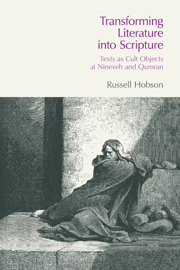Book contents
- Frontmatter
- Contents
- Acknowledgements
- Abbreviations
- 1 Authoritative Texts in the Hebrew and Cuneiform Traditions
- 2 Formulating a New Comparative Approach
- 3 Choosing the Right Texts
- 4 Study One: Enūma Anu Enlil Tablet 63
- 5 Study Two: Mul.Apin
- 6 Study Three: The Laws of Hammurabi
- 7 Study Four: Tablet XI of the Epic of Gilgamesh
- 8 Study Five: Mīs Pî
- 9 Study Six: Manuscripts of Pentateuchal Texts from Near the Dead Sea
- 10 Interpreting the Evidence
- Notes
- Bibliography
- Index of Ancient References
- Index of Authors
- Index of Subjects
2 - Formulating a New Comparative Approach
- Frontmatter
- Contents
- Acknowledgements
- Abbreviations
- 1 Authoritative Texts in the Hebrew and Cuneiform Traditions
- 2 Formulating a New Comparative Approach
- 3 Choosing the Right Texts
- 4 Study One: Enūma Anu Enlil Tablet 63
- 5 Study Two: Mul.Apin
- 6 Study Three: The Laws of Hammurabi
- 7 Study Four: Tablet XI of the Epic of Gilgamesh
- 8 Study Five: Mīs Pî
- 9 Study Six: Manuscripts of Pentateuchal Texts from Near the Dead Sea
- 10 Interpreting the Evidence
- Notes
- Bibliography
- Index of Ancient References
- Index of Authors
- Index of Subjects
Summary
Textual Criticism, Its Objectives and Presuppositions
For most of its history, textual criticism of the Hebrew Bible has been concerned with reconstructing the “original” form of individual scriptural texts. This was understood to be “the text or edition (or a number of consecutive editions) that contained the finished literary product and which stood at the beginning of the process of textual transmission.” Indeed, according to Tov, it was this “final authoritative copy which it is the object of textual criticism to reconstruct, even if only in isolated details.” In effect, the text critic of the Hebrew Bible aimed to reconstruct one text that he or she believed to be historical.
This approach was based on two assumptions. The first was that a single text did in fact stand at the beginning of the transmission process, before it was corrupted by mechanical and recensional processes. The second was that the end result of the process was the standardized form of the Hebrew Scriptures that in effect became the “copy-text” of the Hebrew Bible as it is reflected in all of the medieval manuscript evidence. In the words of Eugene Ulrich, “the term ‘standard text’ implies or even denotes a single text which is not only fixed, but is acknowledged to be ‘the text,’ as opposed to other forms of the text.”
- Type
- Chapter
- Information
- Transforming Literature into ScriptureTexts as Cult Objects at Ninevah and Qumran, pp. 8 - 28Publisher: Acumen PublishingPrint publication year: 2012



